A pontoon boat is a flat-bottomed vessel that relies on buoyant pontoons or tubes to float. Its unique catamaran or trimaran design offers exceptional stability, with a spacious deck area perfect for recreation and leisure activities.
Pontoon boats trace their origins to the 1952 invention by Ambrose Weeres, a farmer from Minnesota who crafted the first models from steel barrels and wooden platforms. Since then, they have evolved into sophisticated watercraft widely used for:
- Cruising
- Fishing
- Watersports (tubing, wakeboarding, etc.)
- Party boats and entertainment
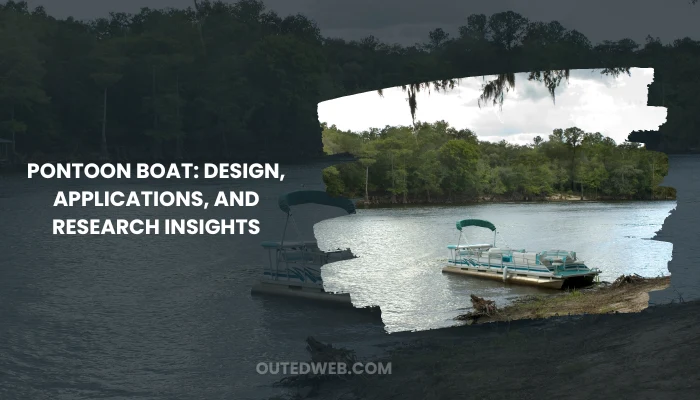
Their key advantages include:
| Advantage | Benefit |
| Shallow Draft | Reduced risk of grounding/underwater damage |
| Spacious Deck Layout | Ample room for amenities (seating, bars, etc.) |
| Stability | Steady platform even in rough conditions |
With their versatility, accessibility, and forgiving nature, pontoon boats have become incredibly popular vessels for both recreation and commercial and industrial applications on lakes, rivers, and coastal waters. So stay with us to learn more!
Design and Construction Of Pontoon Boats
Before you set the course on your aquatic adventures, there’s the exciting (and sometimes technical) phase of design and construction. Let’s dive into the essentials of transforming your dream into a reality!
Hull and Pontoon Design
Pontoon boats typically come in two distinct flavors: catamarans and trimarans. The former features two sleek pontoons running parallel, while the latter boasts an additional cylindrical pontoon at the center, adding an extra layer of stability. These perfectly buoyant tubes are crafted from a variety of materials, each with its own advantages:
- Aluminum: Lightweight yet durable, aluminum pontoons offer low maintenance and corrosion resistance.
- Fiberglass: Sturdy and stylish, fiberglass pontoons can be molded into virtually any shape or design.
- Polyethylene: An affordable option, polyethylene pontoons are impact-resistant and incredibly buoyant.
But the design considerations don’t stop there. The dimensions of the pontoons, their draft (how deep they sit in the water), and their spacing all play crucial roles in determining the boat’s overall performance and capabilities.
It’s a delicate balance of weight distribution, stability, and agility—a balance that experienced pontoon manufacturers have mastered through years of refinement.
Deck and Superstructure
With the foundation laid, it’s time to explore the deck and superstructure—the canvas upon which pontoon life truly unfolds. Here, versatility reigns supreme, as manufacturers offer a dizzying array of layouts and amenities to suit every boater’s needs.
Think up, stretching out on plush seating areas, sipping a refreshing beverage from the built-in bar, or soaking up the sun’s rays on a comfortable sun pad. These are just a few of the luxurious touches that can transform your pontoon into a floating oasis. And when the temperatures soar, retractable canopies and bimini tops provide a much-needed respite from the sun’s scorching rays.
But amidst all the indulgences, safety remains paramount. Sturdy railings and well-designed safety features ensure that your pontoon adventures are as carefree as they are memorable. From secure entry and exit points to strategically placed grab handles, every detail is meticulously considered to keep you and your loved ones secure.
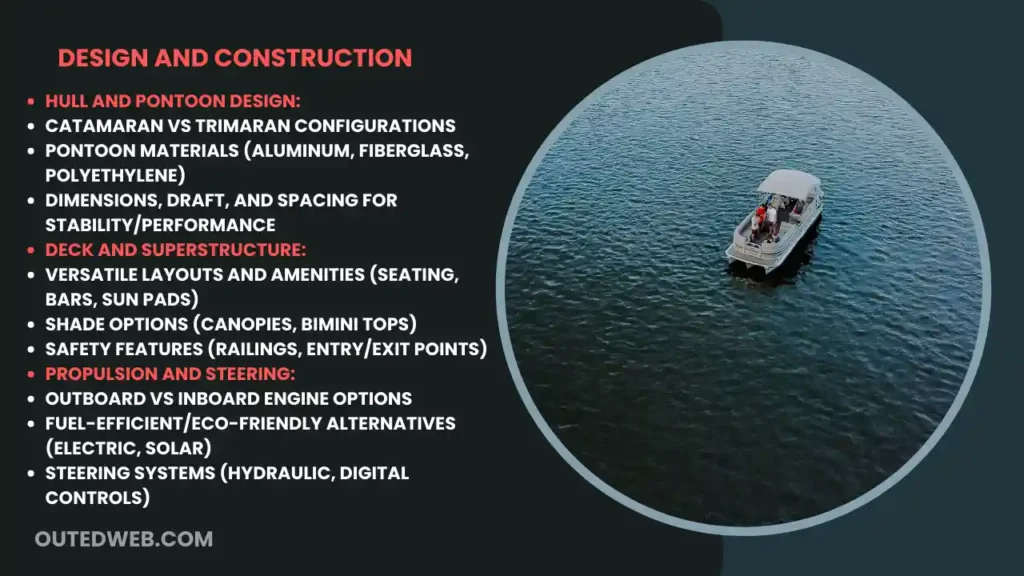
Propulsion and Steering
With the stage set, it’s time to explore the heart that breathes life into your pontoon—the propulsion and steering systems. Here, you’ll find a delightful array of options to suit your specific needs and preferences.
For those seeking raw power and maneuverability, outboard engines offer a tried-and-true solution. These external motors can be easily serviced and replaced, ensuring your pontoon always has the muscle it needs to conquer even the choppiest waters. Alternatively, inboard engines provide a sleeker, more streamlined profile, seamlessly integrated into the vessel’s design.
But what about fuel efficiency and eco-consciousness? Fear not, for the pontoon world has embraced the green revolution with open arms. From electric motors to solar-powered options, there are now plenty of ways to reduce your carbon footprint while still enjoying the thrill of the open water.
And let’s not forget about steering—the critical component that allows you to navigate with precision and confidence. Whether you prefer the classic feel of a hydraulic system or the cutting-edge responsiveness of digital controls, pontoon manufacturers have you covered. With intuitive interfaces and smooth operation, you’ll feel like a seasoned captain from the moment you take the helm.
Applications and Uses Of Pontoon Boats
As we all know, a pontoon boat is a versatile vessel that’s become a favorite among boaters for its comfort, stability, and sheer fun factor. But beyond leisurely cruises, pontoon boats boast a surprising range of applications, making them workhorses for both recreation and industry.
Recreational Boating
Where else can you bask in the sun, cast a line, or carve through the waves with such reckless abandon? These versatile vessels have become the playground of choice for those seeking the ultimate in aquatic leisure. With the simple flick of a rod, you can transform your pontoon into a premier fishing haven, reeling in the catch of the day with ease.
Pontoon boats offer a whole new realm of water sports possibilities. From towing tubes and wakeboards to hosting impromptu diving competitions, these floating playgrounds know no bounds when it comes to high-octane fun. But perhaps the pinnacle of pontoon revelry lies in their ability to transform into the ultimate party boats.
Commercial and Industrial Use
While pontoon boats may be the epitome of leisure, their versatility extends far beyond the realms of recreation. In fact, these buoyant behemoths have carved out a niche in the commercial and industrial sectors, proving their worth time and time again.
For centuries, ferry services have relied on pontoon boats to shuttle passengers and cargo across waterways, their shallow drafts allowing them to navigate even the shallowest of channels.
In regions where traditional infrastructure is lacking, these floating workhorses have become invaluable modes of water transportation, connecting communities and facilitating trade.
But pontoon boats aren’t just limited to ferrying people and goods. They’ve also found their calling as sturdy floating platforms and work decks, providing a stable base for all manner of operations. From construction and maintenance tasks to serving as staging areas for offshore endeavors, these adaptable vessels have become indispensable tools in the industrial arsenal.

Research and Exploration
Just when you thought pontoon boats couldn’t get any more versatile, they’ve gone and raised the bar once again. In the realm of scientific research and exploration, these vessels have proven to be invaluable allies, enabling groundbreaking discoveries and pushing the boundaries of human knowledge.
But the true magic happens when pontoon boats join forces with cutting-edge aquatic robotics. By serving as stable launching platforms for submersible drones and other advanced technologies, these vessels have opened up whole new worlds for exploration. From mapping the ocean floor to studying elusive marine life, the possibilities are virtually endless.
And let’s not forget about the critical role pontoon boats play in sensor deployment. By providing a stable base for a vast array of monitoring equipment, they’ve become invaluable tools in the fight against environmental degradation, helping us better understand and protect our precious waterways.
Hydrodynamic Performance and Stability
As you know, designing large floating objects like oil platforms, wind farms, and wave energy devices poses unique hydrodynamic challenges. How does a multi-story pontoon react to raging ocean swells? What forces does a mooring system experience in a raging storm? I’m going to dive into some of these questions and showcase some cutting-edge research.
Wave Interaction and Motions
The hydrodynamic performance of your trusty vessel has been meticulously engineered to handle even the most challenging conditions.
At the heart of this engineering marvel lies a deep understanding of wave interaction and the intricate motions that ensue. Every aspect of a wave, from its height and period to its direction, plays a crucial role in determining how your pontoon boat will respond. It’s a delicate dance, one that skilled naval architects have studied and perfected over countless iterations.
But even the most advanced pontoon designs can benefit from a little extra help when the waters get rough. Enter mooring systems, those ingenious tethers that anchor your vessel in place, providing an added layer of stability and security. From simple anchors to sophisticated systems that can withstand the mightiest of swells, these unsung heroes ensure your pontoon remains a steadfast oasis, even in the face of nature’s fury.
And for those seeking an even smoother ride, cutting-edge anti-motion devices and stabilizers have your back—quite literally. By counteracting the rolling and pitching motions induced by waves, these innovative systems help maintain a level deck, ensuring your comfort and safety, no matter how turbulent the waters may become.
Hydroelastic Analysis of Large Pontoon Structures
But what happens when pontoon boats outgrow their humble beginnings and evolve into true giants of the seas? Welcome to the realm of very large floating structures (VLFS), where pontoons are no longer mere recreational vessels but massive engineering marvels designed to conquer the oceans.
By studying the complex interplay between the fluid dynamics of water and the elastic properties of these gargantuan structures, engineers can unlock the secrets to their stability and longevity.
From wave energy converters that transform the relentless motion of the seas into clean, renewable power to mobile offshore platforms that enable us to explore the depths like never before, hydroelastic analysis is the key that unlocks their potential.
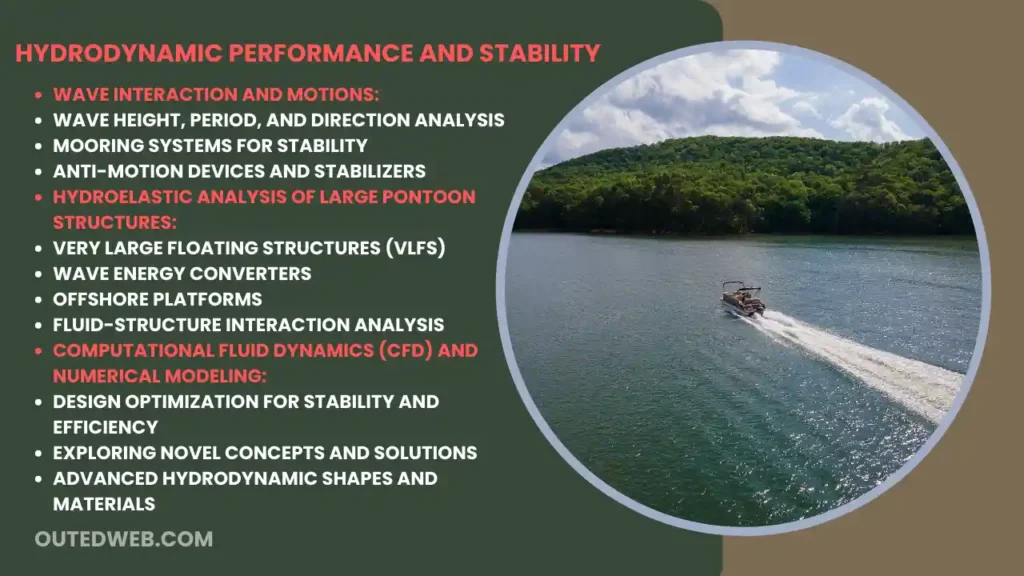
Computational Fluid Dynamics (CFD) and Numerical Modeling
In the ever-evolving world of pontoon design, the quest for perfection knows no bounds. At the forefront of this pursuit lies the powerful realm of Computational Fluid Dynamics (CFD) and numerical modeling.
CFD is more than just a crystal ball; it’s a tool for optimization, a means of refining and perfecting pontoon designs to achieve unparalleled levels of stability and efficiency. By iterating through countless virtual prototypes, engineers can identify and address potential weaknesses, fine-tuning every aspect of the design until it meets the most stringent of performance criteria.
And the benefits don’t stop there. Numerical modeling allows for the exploration of novel concepts and innovative solutions, pushing the boundaries of what’s possible in pontoon design.
From hydrodynamic shapes that slice through the water like hot knives through butter to advanced materials that defy the laws of conventional engineering, the realm of numerical modeling is a fertile playground for the boldest and most creative minds.
Environmental Considerations
We know that pontoons are fantastic for cruising and enjoying the water, but we also need to consider their impact on the underwater world—the aquatic ecosystems teeming with life. Here’s where things get interesting!
Impact on Aquatic Ecosystems
As we revel in the delights of pontoon boating, it’s essential to remember that our actions have far-reaching consequences, particularly for the delicate ecosystems that call our waterways home.
From the sediment-dwelling benthic communities that form the foundation of aquatic life to the majestic marine creatures that grace our oceans, every aspect of the ecosystem is vulnerable to the impact of our pontoon adventures.
It’s a sobering thought, but one that responsible pontoon enthusiasts must confront head-on. By understanding the potential disturbances our vessels can cause, we can take proactive steps to minimize our footprint and preserve the natural balance that sustains us all.
Sustainability and Green Initiatives
For the pontoon, industry has embraced the call for sustainability with open arms. From eco-friendly materials that minimize our reliance on finite resources to innovative construction methods that prioritize efficiency and waste reduction, the pursuit of a greener future is well underway.
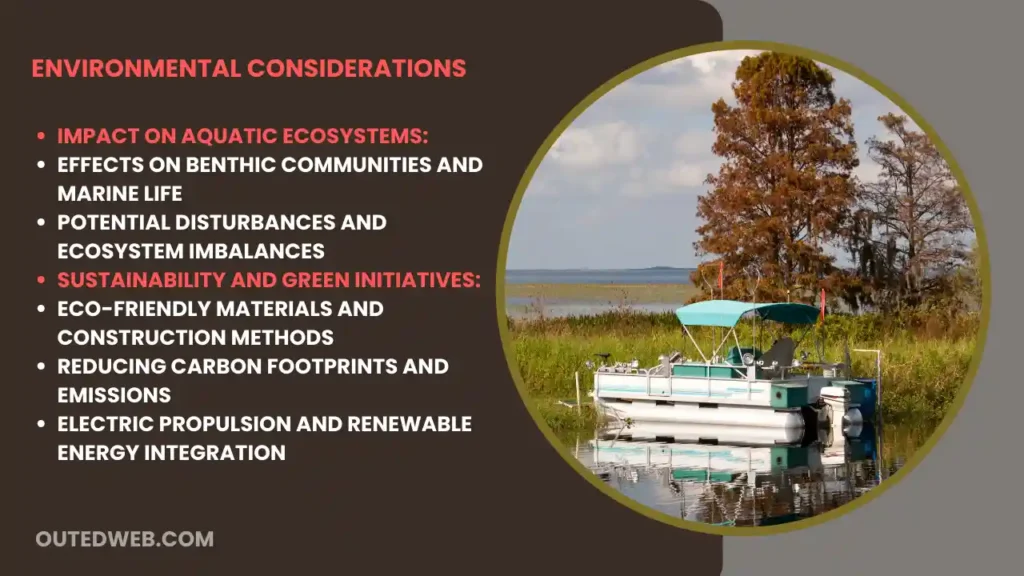
And let’s not forget about the strides being made in reducing carbon footprints and emissions. Whether it’s the adoption of electric propulsion systems or the integration of renewable energy sources, pontoon manufacturers are leaving no stone unturned in their quest to create vessels that tread lightly upon the earth.
So, as you set sail on your next pontoon adventure, take comfort in the knowledge that you’re part of a movement—a collective effort to preserve and protect the very waters that have brought us so much delight and wonder.
In the end, it is only by striking a harmonious balance between human pursuits and environmental stewardship that we can truly appreciate the beauty and majesty of the world around us.
Safety and Regulations
We’ve explored the science behind pontoons and their impact on the environment, but let’s not forget the most important aspect – safety. Just like any adventure, a little preparation goes a long way in ensuring a smooth and enjoyable time on the water.
Design Standards and Guidelines
As thrilling as pontoon boating can be, it’s crucial to remember that safety should always take priority. That’s why the industry has established a comprehensive set of design standards and guidelines to ensure that every vessel meets the highest levels of safety and security.
From railing requirements that provide sturdy barriers against accidental falls to mandated safety equipment like life jackets and emergency flares, these guidelines leave no stone unturned.
And let’s not forget about the all-important capacity limits and stability criteria, which dictate the maximum number of passengers and cargo a pontoon can safely accommodate, ensuring a well-balanced and secure ride, no matter the conditions.
Compliance with these standards isn’t just a box to check; it’s a solemn promise to every pontoon owner and guest that their well-being is the top priority. And with regular inspections and rigorous enforcement, you can rest assured that your pontoon adventure will be as safe as it is exhilarating.
Operator Training and Licensing
But even the safest pontoon boat is only as secure as the person at the helm. That’s why responsible boating education and certification programs have become the norm, equipping pontoon enthusiasts with the knowledge and skills they need to navigate the waters with confidence and respect.
From basic seamanship and navigation to advanced techniques for handling emergencies and adverse conditions, these comprehensive training programs cover every aspect of safe and responsible pontoon operation.
For those seeking an extra level of proficiency, specialized licensing options are available, ensuring that only the most qualified individuals are entrusted with the care and control of these magnificent vessels.
At the end of the day, risk management isn’t just about following the rules; it’s about cultivating a deep respect for the power of the water and the responsibility that comes with commanding a pontoon boat. By embracing this mindset, we can ensure that every voyage is a safe and memorable one, filled with moments of pure bliss and awe-inspiring beauty.
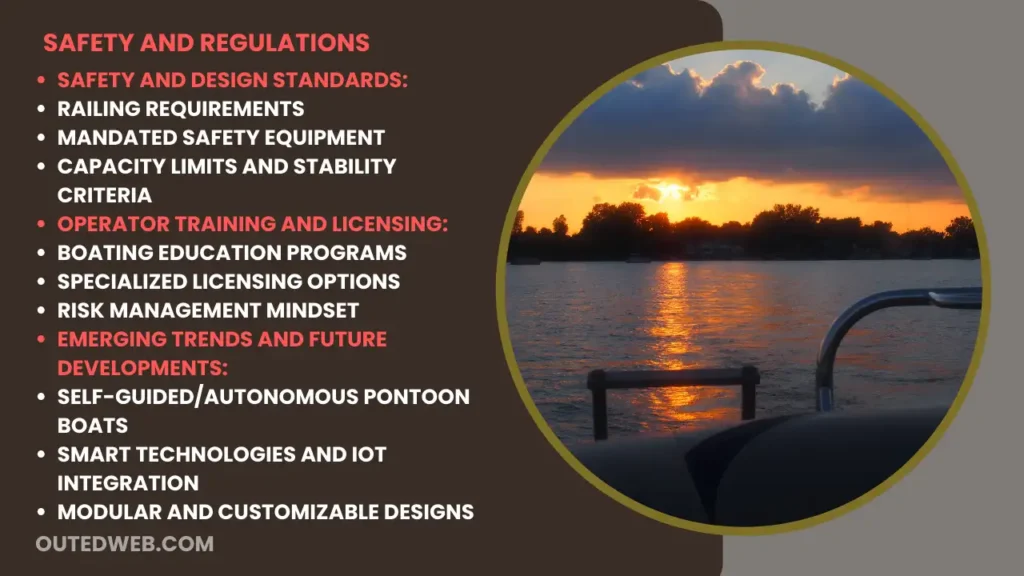
Emerging Trends and Future Developments
Just when you thought the pontoon boat had reached the pinnacle of innovation, the industry is poised to take yet another giant leap forward. Brace yourself, for the future of pontoon boating is an exciting one, filled with cutting-edge technologies and game-changing advancements.
No longer bound by the limitations of human operation, these self-guided vessels could revolutionize everything from recreational boating to commercial transportation, ushering in a new era of efficiency and convenience.
But that’s just the tip of the iceberg. As we delve deeper into the world of smart technologies and the Internet of Things (IoT), pontoon boats are poised to become truly intelligent companions. From advanced navigation and monitoring systems to seamless integration with our digital lives, the possibilities are endless.
And let’s not forget about the boundless potential of modular and customizable pontoon designs. Whether you’re seeking a luxurious floating lounge or a rugged workhorse for industrial applications, the future of pontoon boating promises unparalleled flexibility and adaptability.
Frequently Asked Questions
What Is the Difference Between a Pontoon Boat And a Traditional Boat?
While both are vessels designed to conquer the waves, pontoon boats stand apart with their unique design and construction. Instead of a traditional hull, these aquatic marvels rely on buoyant pontoons—essentially, large tubes or cylinders that provide exceptional stability and a level deck.
This innovative approach offers a spacious, comfortable ride that traditional boats simply can’t match, making pontoons the perfect choice for leisurely cruising, entertaining, or even fishing expeditions.
How Stable Are Pontoon Boats in Rough Water Conditions?
Stability is one of the key selling points of pontoon boats, and for good reason. Thanks to their wide beam and low center of gravity, these vessels are remarkably resilient in choppy waters.
Even when faced with sizable waves or strong winds, pontoon boats maintain their composure, providing a steady platform that keeps you and your guests feeling secure and comfortable.
Of course, as with any watercraft, it’s always wise to exercise caution and good judgment, but rest assured that pontoon boats are designed to handle a fair bit of rough and tumble.
Can Pontoon Boats Be Used in Saltwater Or Ocean Environments?
While pontoon boats have traditionally been associated with calm, inland waters like lakes and rivers, their versatility knows no bounds.
Many modern pontoon models are constructed with saltwater-resistant materials, making them perfectly capable of handling the more corrosive nature of oceanic environments.
Whether you’re seeking to explore coastal waters, embark on a fishing excursion, or simply soak up the salty sea air, pontoon boats are more than up to the task; just be sure to properly maintain and care for your vessel to ensure its longevity.
What Is the Typical Lifespan And Maintenance Required for Pontoon Boats?
When properly cared for, pontoon boats can provide years—even decades—of faithful service. With regular maintenance, such as cleaning, waxing, and inspecting for any potential issues, these hardy vessels can withstand the elements and continue delivering unforgettable adventures.
Of course, as with any watercraft, certain components may need to be replaced over time, but with a little care, your pontoon boat can remain a beloved companion for generations to come.
Are Pontoon Boats Suitable for Fishing And Water Sports Activities?
Absolutely! In fact, pontoon boats are perfectly suited for a wide range of aquatic pursuits, from leisurely angling to adrenaline-pumping water sports.
Their spacious decks provide ample room for casting lines or setting up fishing gear, while their stability ensures a comfortable and secure platform for reeling in your catch.
When it comes to activities like tubing, wakeboarding, or even diving, pontoon boats offer the ideal combination of space, stability, and power to keep the excitement going all day long.
How Do Pontoon Boats Compare in Terms of Fuel Efficiency And Environmental Impact?
In today’s eco-conscious world, pontoon boats are emerging as surprisingly efficient and environmentally friendly choices. Thanks to their lightweight construction and efficient hull designs, many pontoon models boast impressive fuel economy, helping to reduce emissions and minimize their carbon footprint.
Additionally, manufacturers are increasingly exploring alternative propulsion systems, such as electric motors or solar power, further enhancing the eco-friendly nature of these vessels.
What Safety Features And Regulations Are Specific to Pontoon Boat Design And Operation?
Safety is paramount in the world of pontoon boating, which is why these vessels are subject to a comprehensive set of design standards and regulations.
From sturdy railings and capacity limits to mandated safety equipment like life jackets and emergency flares, every aspect of a pontoon boat is meticulously engineered with your well-being in mind.
Additionally, responsible boating education and licensing programs help ensure that operators are fully equipped to navigate the waters with confidence and respect.
Final Verdict
Pontoon boats have truly carved out a unique niche in the world of watercraft, offering a delightful blend of stability, versatility, and pure enjoyment.
From leisurely cruises and adrenaline-fueled water sports to commercial applications and scientific exploration, these buoyant marvels continue to push the boundaries of what’s possible on the water.
As we look ahead, the future of pontoon boating shines brighter than ever, with cutting-edge technologies and innovative designs poised to redefine our aquatic adventures.
Whether you’re a seasoned pontoon enthusiast or a curious newcomer, one thing is certain: the call of the open water has never been more alluring, and the possibilities have never been more exciting. Embrace the journey, and let the adventures begin!

